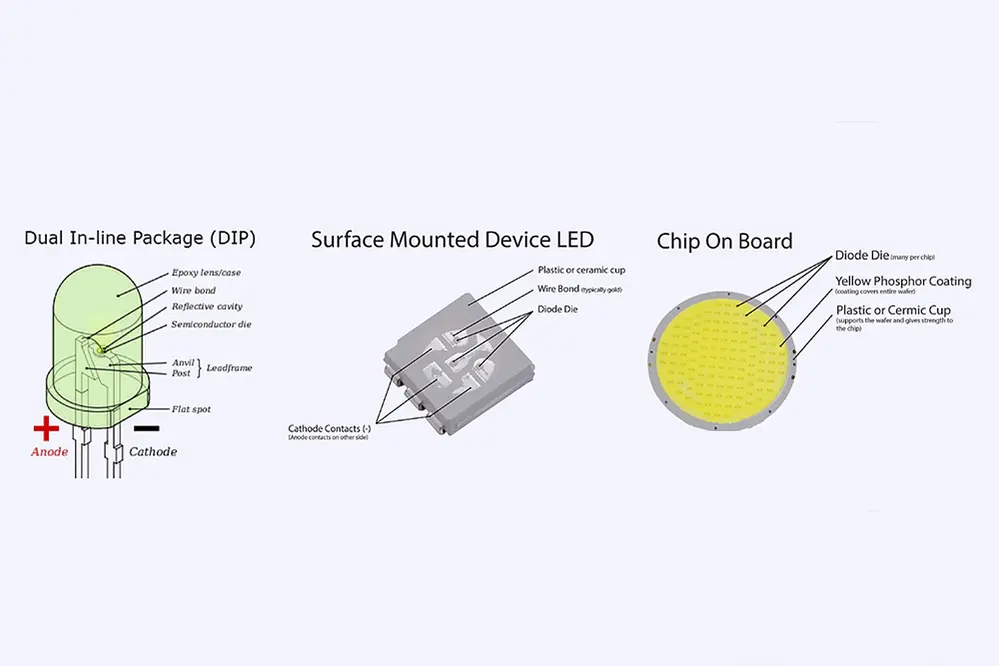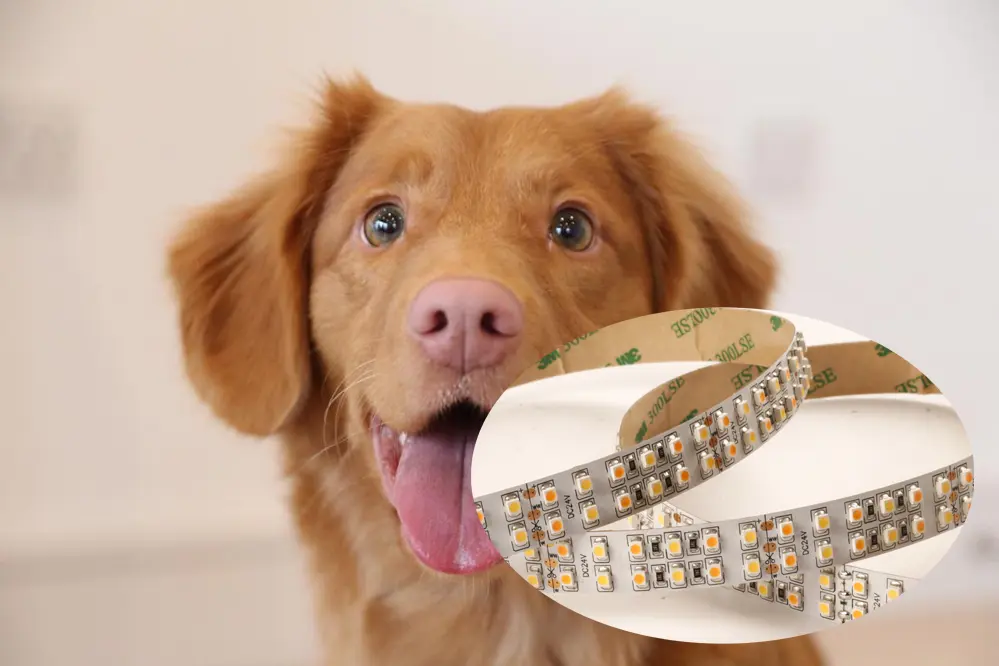Are you concerned about the impact of LED lights on your furry friend’s eyes? Look no further! In this blog post, we will delve into the question, “Do LED Lights Hurt Dogs’ Eyes?” and provide you with all the information you need to protect your pup.
LED lights do not directly harm dogs’ eyes. However, certain factors such as the intensity and duration of exposure can have an impact, and it is essential to create a safe environment for your dog by managing these aspects appropriately. It’s important to understand the potential risks and take necessary precautions to ensure your dog’s eye health.
Discover the science behind LED lights and their effects on the eyes of canine pets, as well as practical tips on how to minimize any potential harm. Don’t miss out on this essential knowledge to safeguard your furry companion!
Exploring Canine Vision

Dogs perceive the world through a visual system starkly different from humans, with adaptations for dim light and motion detection.
Their sight is attuned primarily to movement and shades of blue and yellow, due to the predominance of rods over cones within their retinas, lending them enhanced night visibility but reduced color discrimination.
The term “dichromatic” versus “trichromatic” encapsulates the fundamental distinction in color perception between dogs and their human companions.
Differences Between Dog and Human Eyes
The canine visual system prioritizes motion detection over the vivid color discrimination that humans experience, delineating a significant perceptual divide.
Dogs possess a higher concentration of rod photoreceptors, which excel in low-light vision but result in a more limited color spectrum compared to humans.
Dogs can see in ultraviolet, a spectrum totally invisible to the naked human eye.
While dogs have fewer cone photoreceptors, they compensate with a broader field of view and quicker motion detection, traits vital for their survival instincts. Through the lens of ophthalmology, we understand that their vision is adept at picking up subtle movements, an evolutionary advantage in their ancestral hunting practices.
Canine Sensitivity to Light
Dogs perceive light differently than humans do, primarily due to the structural variances in their eyes. A dog’s retina is rich in rod photoreceptors, which are highly sensitive to low levels of light, facilitating their superior night vision compared to ours.
However, these same rods also render them more susceptible to bright light. The canine eye, while adept at detecting movement and navigating in dim conditions, does not handle intense illumination with the same ease. Overexposure to bright light sources can cause discomfort or even pain, much like the human experience of looking directly at the sun.
The impact of light on a dog’s eyes extends to artificial sources, such as LED lights. Although not inherently harmful, LED lights can sometimes emit a flicker at a frequency that is imperceptible to the human eye, yet detectable by canine vision. Such a flicker can be a source of irritation or disorientation for dogs, particularly in instances of prolonged exposure.
Consequently, due consideration must be given to the intensity and quality of lighting in environments shared with dogs. As responsible caregivers, it is pivotal to ensure that the spectral output and brightness levels of artificial lighting do not overwhelm our canine companions. Acknowledging their visual capabilities and sensitivity to light is essential in safeguarding their ocular health and overall well-being.
LED Lights Characteristics

LED lights boast a diverse array of applications, attributed to their robust design, versatility, and energy efficiency. Their compact form allows for innovative configurations that can illuminate spaces with precision and uniformity. Additionally, LEDs have an extensive lifespan, reducing the need for frequent replacements, hence advocating for an environmentally sustainable choice in lighting solutions.
The spectral output of LED lighting is notably controllable, allowing for customization of light intensity and color temperature to meet specific environmental needs. While generally benign, it is crucial that lighting systems are properly assessed to ensure they are devoid of harmful flicker rates or excessive brightness that could adversely affect the occupant’s visual comfort, including that of canine companions.
Flicker Rates in LEDs
Flicker in LED lighting refers to a rapid variation in light output that can lead to discomfort and potential health concerns.
- Temporal Modulation: LEDs can exhibit fluctuations in brightness over time due to their power supply characteristics.
- Human Detection Threshold: Typically, humans may not perceive flicker at rates above 80 Hz, but sensitive individuals might react to lower rates.
- Canine Sensitivity: Dogs have different visual systems and may detect flicker at higher rates than humans, possibly leading to discomfort or stress.
While imperceptible to most humans, flicker rates in LEDs can be discernible to canines, necessitating careful consideration in dog-friendly environments.
Ensuring that LED lighting systems adhere to industry recommendations can mitigate flicker effects, supporting both human and canine ocular health.
LED Color Spectrum
The visible spectrum of LED lighting can vary significantly based on the light source’s design and purpose.
While primarily designed to cater to human vision, LEDs also emit light wavelengths perceived differently by the eyes of canine pets, highlighting the need for pet-friendly lighting solutions.
Dogs possess a dichromatic vision, perceiving colors primarily in shades of blue and yellow, with varying sensitivity to other colors in the spectrum.
The intensity and range of colors in the LED spectrum can impact a dog’s ocular health if not attuned to their unique visual requirements.
Careful selection of LED lighting with consideration for the canine color spectrum is vital in shared human-canine environments.
Potential Risks of LEDs for Dogs

High-intensity LEDs have the potential to cause photochemical damage in canine retinas, which may result in inflammation or degenerative conditions over prolonged exposure, often referred to as LED toxicity. Like in humans, phototoxicity is contingent upon the light intensity and duration of exposure, but canines might be at higher risk due to their tendency to stare at sources of bright light and their differing ocular physiology.
Moreover, the thermal effects of higher wattage LED bulbs could potentially elevate the local ambient temperature, creating an uncomfortable environment with a risk of heat-induced discomfort or distress for canines. The selection of appropriate luminaire design and installation placement is therefore crucial to minimize these thermal risks.
Photobiological Effects on Dogs
The physiological makeup of a dog’s eye exhibits distinct differences from that of humans, which has implications for photobiological effects associated with LED lighting. Their visual system is adapted for superior night vision, leading to a heightened sensitivity to certain types of light, particularly in the blue spectrum.
LED lights, often celebrated for their energy efficiency and longevity, emit a high level of blue light, which can potentially lead to a higher risk of photochemical retinal damage in dogs than in humans. Also, the flicker produced by some LED lights, imperceptible to humans, may be detected by dogs, causing visual discomfort or stress.
Flicker sensitivity in dogs might not only cause discomfort but also elicit behavioral changes or anxiety. Furthermore, some spectral compositions of LED lighting can potentially affect the circadian rhythms of dogs, potentially disrupting their sleep-wake cycles and overall well-being.
In conclusion, while the photobiological impacts of LED lighting on dogs require further empirical study, it is prudent to consider the characteristics of LED products and their effects on canine vision. The balance between benefits and potential hazards should be carefully weighed, especially in spaces where dogs have prolonged exposure to artificial lighting, ensuring their ocular health and comfort are not inadvertently compromised.
Behavioral Changes Due to LED Exposure
Exposure to LED lighting, especially those with high blue light emission, may induce behavioral alterations in dogs.
- Anxiety and Restlessness: Manifestation of stress due to the flickering effect of LED lights.
- Disturbed Sleep Patterns: Disruption of circadian rhythms influenced by artificial light sources.
- Increased Aggression: Potential behavioral response to the discomfort or irritation from light.
- Decreased Appetite: Changes in feeding behavior which might be related to stress or discomfort.
- Impaired Visual Navigation: Difficulty in visual acuity and spatial awareness, leading to confusion or hesitancy.
These behavioral shifts suggest a discomfort or a negative impact on canine well-being.
Attention to lighting choices can mitigate these effects and promote a healthy environment for dogs.
Ensuring Dog Eye Safety

To safeguard the ocular health of canines, it is imperative to choose lighting that emits a spectrum conducive to their well-being. LED lights with a lower color temperature, simulating natural daylight without excessive blue light, are preferable to preserve canine vision and prevent potential retinal damage.
Further protective measures include regulating the intensity and duration of LED exposure for dogs. Employing dimmable LED solutions and avoiding direct eye contact with high-intensity beams can significantly reduce the risk of photo-oxidative stress. Integrating these lighting strategies with a thorough understanding of canine visual preferences will ensure that light sources in their environment are both beneficial and non-disruptive.
Appropriate LED Lighting Choices
When selecting LED lights for environments inhabited by dogs, it is crucial to consider the spectral power distribution (SPD) of the lighting fixtures, which reflects the composition and quality of light emitted, in order to minimize ocular strain and promote visual comfort.
Choose LEDs with a high Color Rendering Index (CRI) to ensure that the light quality promotes accurate color perception for both humans and canines, enhancing the visual experience for all.
Furthermore, consider LEDs that offer adjustable color temperatures, allowing for customization that suits various activities and times of day, thereby supporting the circadian rhythms of dogs.
Ensure that LEDs used in dog-inhabited spaces are devoid of UV radiation, as excessive exposure can be harmful to canine eyes, similar to the effects in humans.
To cater to a dog’s sensitivity to flicker, opt for LEDs with a high flicker-free rate to minimize the potential for distress or neurological effects, ensuring a calm and stable visual environment.
Finally, the use of diffusers on LED fixtures can soften the emitted light, reducing glare and creating a more ambient illumination that is comfortable for dogs’ eyes, while also providing satisfactory lighting for human occupants.
Expert Recommendations for Dog-Friendly Lighting
To safeguard canine ocular health, prioritize LEDs with minimal blue light emission, as excessive blue light can induce discomfort and potential harm over time.
Since dogs possess a distinct visual system, lighting should cater to their spectral sensitivity. Employing LEDs with tailored spectra can mitigate the risk of photochemical damage to canine retinas.
In terms of luminosity, avoid overly bright environments. Choose LEDs that offer dimmable features, delivering a range of intensities that cater to different scenarios and comport with the dog’s comfort levels.
Integration of motion sensors can offer an adaptive lighting solution—dimmable LEDs that adjust according to occupancy and activity, thereby reducing unnecessary exposure to artificial light for dogs.
Regular evaluations of lighting installations are recommended to confirm they continue to comply with safety standards for dogs, ensuring their environments remain visually comfortable and secure.
FAQs
What LED light color is best for dogs?
LED light color can play a significant role in the well-being of our canine friends. It’s important to choose the right color to ensure their comfort and optimize their visual experience.
Blue light, for example, is known to have a calming effect on dogs. It can help them relax and reduce anxiety, making it a good choice for nighttime lighting or in areas where dogs tend to rest or sleep. Blue light can also enhance their visibility in low-light conditions.
On the other hand, warmer colors like yellow or amber can create a cozy and inviting atmosphere for dogs. These colors mimic the natural warm light of the sun and can help create a soothing and comforting environment for them.
It’s important to note that dogs have different visual sensitivities compared to humans. They have more rod cells in their eyes, which are responsible for detecting motion and seeing in low light. Therefore, lighting with a higher intensity or brightness might be more appropriate for them.
Choosing the best LED light color for dogs ultimately depends on their individual preferences and needs. Observing their behavior and responses to different lighting conditions can provide valuable insights into what color they prefer and feel most comfortable with.
In summary, blue light can have a calming effect on dogs, while warmer colors like yellow or amber can create a cozy environment. It’s essential to consider their visual sensitivities and observe their responses to determine the best LED light color for your furry companion.
What color LED lights can dogs see?
Dogs have a different perception of color compared to humans. While humans have three types of color receptors, dogs only have two. This means that dogs can see fewer colors than we can.
The two color receptors in dogs are sensitive to shades of blue and yellow, rather than the full range of colors like we see. This means that dogs see the world in primarily blue and yellow tones. They have a limited ability to see shades of green and some shades of red as well.
However, dogs cannot see the same vibrant spectrum that humans can. Colors that look bright and vivid to us may appear dull or muted to them. This is because their color vision is not as developed as ours.
It’s important to keep in mind that while dogs may not see the same range of colors as humans, they have other visual abilities that excel beyond ours, such as better low-light vision and motion detection. So, even though they may not see the same array of colors, they can still perceive and navigate the world effectively.
Are blue LED lights bad for dogs’ eyes?
Blue LED lights do not necessarily pose a significant risk to dogs’ eyes. The concern with blue LED lights stems from their higher frequency and intensity compared to other colors. However, if the lights are used responsibly and within safe parameters, the potential harm to dogs’ eyes is minimal.
Research suggests that blue light exposure can contribute to retinal damage in certain circumstances. Dogs have a different visual system than humans, which makes them more susceptible to certain light wavelengths. However, it’s important to note that the harmful effects of blue light are usually associated with prolonged exposure at close range.
To mitigate any potential risks, it is advisable to limit the amount of time dogs spend in direct proximity to blue LED lights, especially if the intensity is high. Additionally, ensuring that the lights are not excessively bright or pointed directly at the dogs’ eyes can help minimize any adverse effects.
Overall, while blue LED lights may have the potential to be detrimental to dogs’ eyes under certain conditions, responsible use and appropriate precautions can help ensure the safety and well-being of our furry friends. It’s always a good idea to consult with a veterinarian if there are any concerns about the impact of LED lights on dogs’ eyes.
How do LED lights impact dogs’ eyes?
LED lights can have an impact on dogs’ eyes. The bright and intense light emitted by LED lights can be uncomfortable for dogs, just as it can be for humans. Dogs have sensitive eyes, and exposure to excessive or direct LED light can cause discomfort and even temporary vision issues.
It’s important to note that dogs’ eyes are adapted for low-light conditions and have a higher sensitivity to certain wavelengths of light, including blue light. LED lights, especially those with a high blue light output, can potentially disrupt their natural circadian rhythm and cause eye strain.
Excessive exposure to LED lights can also lead to a condition called “photophobia” in dogs, which is an extreme sensitivity to light. This can result in dogs squinting, blinking excessively, or avoiding areas with bright LED lighting.
To ensure the well-being of dogs, it is recommended to provide them with a suitable lighting environment that minimizes exposure to intense LED lights. Shielding LED lights or using dimmers can help reduce the intensity of the light and create a more comfortable atmosphere for dogs.
In summary, LED lights can impact dogs’ eyes due to their sensitivity to light and the potential disruption of their circadian rhythm. Taking precautions and using appropriate lighting techniques can help mitigate the negative effects of LED lights on dogs’ eyes.
Should LED lights be avoided around dogs?
LED lights are generally safe to use around dogs. However, it is important to take a few precautions to ensure their well-being.
Dogs have sensitive eyes, and exposure to bright lights, including LED lights, can cause discomfort or irritation. It is advisable to avoid placing bright LED lights directly in their line of sight, especially at close proximity. This can help prevent any potential issues or discomfort for your furry friends.
Additionally, it is essential to choose LED lights with a color temperature that mimics natural light. Dogs, like humans, thrive in environments that provide a balance of warm and cool light. Opting for LED lights that emit a natural and balanced color spectrum can help create a more comfortable and soothing atmosphere for your canine companions.
In summary, while LED lights can be used around dogs, it is important to be mindful of their sensitivities. Avoid placing bright lights directly in their line of sight and choose LED lights with a color temperature that mimics natural light for a more comfortable environment. By taking these precautions, you can create a well-lit and dog-friendly space for your furry friends.
Conclusion
Illumination safety for dogs is paramount.
Careful selection of LED lighting, geared towards canine well-being, is essential. To avoid detrimental effects, one must seek out LEDs optimized for dogs’ eyesight—units with lower blue light emission, compatible intensity levels, and adaptive lighting technologies. These criteria are crucial for maintaining a dog-friendly environment.
Canines deserve considerate lighting design.
Employing motion-sensitive, dimmable LEDs is not merely a convenience—it is a responsibility for pet owners. These features ensure that light adapts to a dog’s activity levels, thus promoting ocular health and general comfort.
Opt for LEDs that respect canine visual needs.
With the ongoing advancements in lighting technology, especially as we navigate into the latter part of 2023, it becomes increasingly feasible to implement lighting solutions that are both advanced and considerate of our canine companions. Tailored LED options that mitigate potential phototoxic risks offer a promising path for dog-friendly lighting practices.





